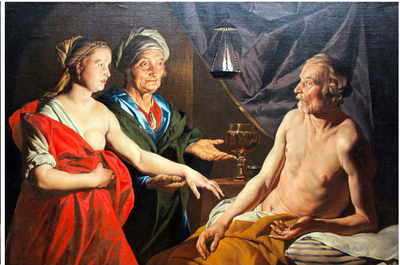The Eyes Have It: Looking at the Text


Matthias Stom’s “Sarah Leading Hagar to Abraham” (c. 1638)—brought to my attention by Mimi Kaplan, a student at the Albert A. List College of Jewish Studies of The Jewish Theological Seminary—is a proverbial picture worth a thousand words. The three figures, in three different stages of (un)dress, looking in three different directions, encapsulate the difficulties they will encounter as their lives become further entangled. Although Abraham and Sarah almost seem to be communicating, their left hands open, facing upward toward each other, Sarah looks not at Abraham, but off into space. No one is happy; this situation will rapidly deteriorate.
Stom’s depiction of the bodies indicates that Sarah, the only figure who is fully clothed—albeit in the garb of a contemporary matron—will be the dominant figure, the one who has her way at this point and who will continue to prevail. Hagar, her body full and youthful, one breast revealed to project her fertility, clothed in seductive red, cannot even direct her own hand. Sarah deprives her slave of agency, literally forcing her hand. No Kierkegaardian “knight of faith,” Abraham, his torso revealed, is old, gaunt, and weak, supporting himself on an elbow. No wonder Hagar hesitates to approach him.
Stom’s painting constitutes a midrash on Genesis 16:1-3, providing the viewer with a concise visual interpretation of the emotions swirling in the biblical text.



